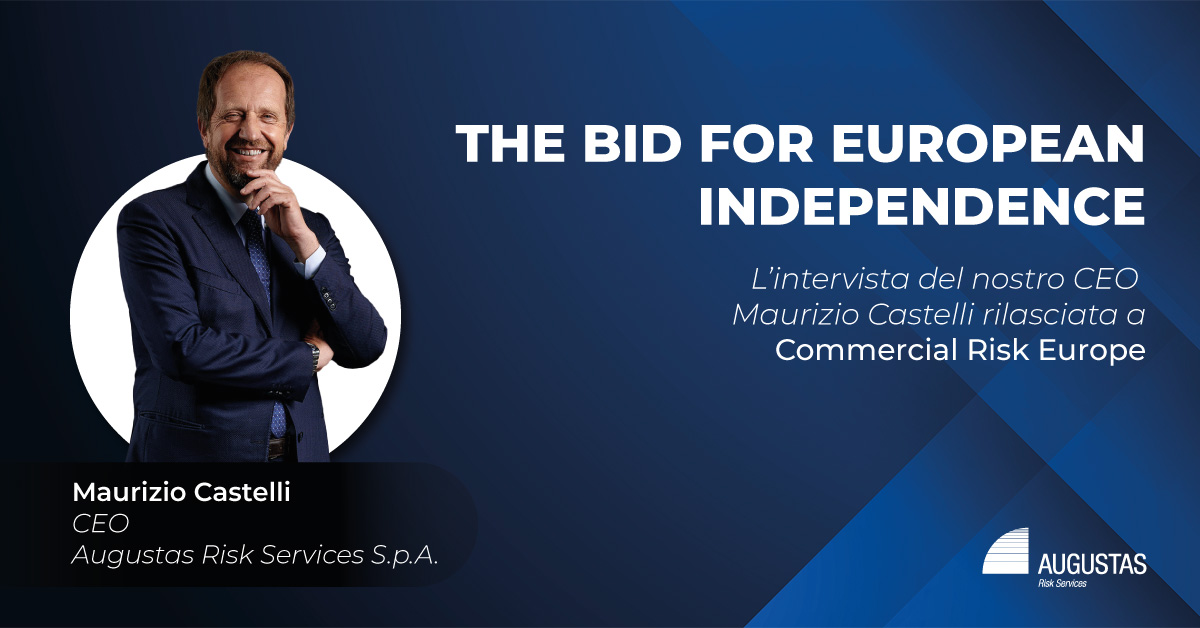
11 Nov THE BID FOR EUROPEAN INDEPENDENCE
Condividiamo l’intervista del nostro CEO Maurizio Castelli rilasciata a Commercial Risk Europe, che ringraziamo per l’attenzione e la collaborazione.
Guardando al futuro, Castelli identifica le sfide chiave per i risk manager, tra cui la difficoltà di utilizzare dati storici per prevedere sviluppi futuri in un’era di “policrisi”, l’importanza crescente dell’analisi predittiva e dell’AI, e la necessità di affrontare rischi come l’instabilità geopolitica, gli eventi meteorologici estremi e le minacce cyber. Castelli sottolinea inoltre l’importanza di una governance dei rischi sistemici che coinvolga governi, mercati e società civile, evidenziando il ruolo cruciale che l’UE e i governi nazionali devono svolgere nella gestione di questi rischi complessi e interconnessi.
THE BID FOR EUROPEAN INDEPENDENCE
Maurizio Castelli was president of Ferma from the end of 1998 until the end of 2001. The Italian was part of the Ferma board that gained ‘independence’ from Rims that, up till then, had co-financed the annual Ferma event in Monte Carlo. He was in charge when Ferma set up its first office and hired Florence Bindelle as its first permanent CEO. Castelli is now the founding CEO of Augustas Risk Services, recently replaced Jorge Luzzi as leader of the Risk Management Practice at Brokerslink after his sad death, and is a board member of the Italian association Anra. He spoke to Ben Norris about his time in charge and the big themes facing risk managers then, and in today’s complex world.
Ben Norris (BN): What were the big challenges and achievements of your presidency?
Maurizio Castelli (MC): The big challenge was to launch the ‘new Ferma’ and win the bet of becoming a ‘truly independent’ European organisation. Previously, the bi-annual conference was always held in Monte Carlo, and it was known as “The Monte Carlo Rims” since Rims was fully financing it, and was heavily involved in the organisation, although the profit was split 50-50 with Ferma.
As president, along with my board, which was a great team, we organised in Berlin in 1999 the first forum away from Monte Carlo, and without any financial support from Rims. With this, we started the new approach of rotating the venue around major European cities. We also rented temporary office space in Brussels as a real headquarters for Ferma (previously just a mailbox), and hired our first full-time employee — Florence Bindelle, a great hire.
We then organised the following forum in Barcelona in 2001, and the rest is history! I think it was an incredible achievement of myself and of my board and team to win this crazy bet, which was the starting point for Ferma as we know it today.
In terms of risk management themes, the start of the era of corporate governance and of ERM was the big theme, and the major breakthrough event towards the end of my presidency was September 11. This changed our lives, but also completely changed the insurance industry and the risk management role.
BN: How has risk and insurance management developed or changed in recent years and since your time in office?
MC: Well, unfortunately I’m getting old and my time in office (1998-2001) was in the stone age of risk management. The development of the profession over the last 25 years has been incredible. Before the 2000s risk management was still mainly operational, technical and financial, and the main risk treatment tools available to risk managers were insurance, risk engineering and for the most sophisticated companies — captives.
Enterprise Risk Management (ERM) really became a discipline and not just a theory in this century, and when I was president we were just starting to speak about it as big news and discuss the direction risk managers should probably take to enhance their professional and career development.
Today we see the combination of a more holistic and sophisticated approach. We have also seen the increased severity, complexity and interconnection of risks that has made risk management a board level topic, and certainly a much more strategic tool than in the past.
Obviously, you also have to consider the size of the company. Large corporations that already had a risk culture, have moved in the direction I just described. However, it is also extremely important to mention that risk management is not any more just for big companies. The risky environment, and the regulatory and supply chain constraints are pushing companies, of any size, to have a risk management process and function in place. This is for me probably the most important development because it exponentially increases the development of a risk management culture.
“During my time as president, risk management was still a topic only known to a handful of experts. Typically over dinner I had a hard time explaining what I did for a living. Today however, it seems everybody knows what risk management is.”
Maurizio Castelli
BN: How has the corporate and commercial insurance market changed? Is it as relevant today as it once was? What role are ART and captives going to play in risk transfer?
MC: The insurance market had to try to cope with the major changes I described, and the challenge to remain relevant is, in my opinion, still ongoing. Take cyber risk as an example: the relevance of the risk to companies of any size and any industry is continuing to increase, and the availability of meaningful (in terms of scope of cover and of capacity) insurance to cover this is still very limited.
Certainly, there have been efforts from some of the major international players to come up with solutions, combining traditional insurance with risk management services and with ART components. But this is still at an initial stage, and I think this should be the way for insurance to remain relevant.
“There are signs the hard market may already be showing some sign of softening in 2025, although this will probably be slow, and with differences across classes and with big selectivity among different insured industries.”
Maurizio Castelli
“In this context, I see ART as a potentially important tool for insurers/reinsurers to offer hybrid solutions that could significantly enhance their capacity for emerging risks. On the other hand, ART and the use of the captive as a direct tool for insureds is, in my opinion, still limited to a small group of very large multinational corporations. Making these tools more simple and more accessible to a wider audience is a big challenge, but one that should be pursued.”
Maurizio Castelli
BN: How could the insurance market collectively finally conquer the boom and bust market cycles?
MC: We are at the moment experiencing the first real hard market after decades of soft market, and I’m pretty sure that once again, it will not last forever. There are signs that the hard market may already be showing some sign of softening in 2025, although this will probably be slow, and with differences across classes, and with big selectivity among different insured industries.
I think insurers have missed the opportunity of a lifetime to be much more selective in their underwriting, depending on the level and quality of risk management of the insured. During the hard market, a waste management company, for example, could not obtain insurance at a decent level of premium, no matter what. However, there were companies in that industry, with excellent risk engineering and risk management programmes and with a great loss ratio, that deserved decent terms and conditions. They were, however, treated in exactly the same way as other companies that were doing nothing at all in terms of risk management. If this continues, the insurance industry will never get rid of market cycles.
BN: What are the big themes and risks that Ferma and the national associations need to focus on in the next five to ten years?
MC: Five to ten years in this turbulent world is an eternity, and unfortunately risk managers have not been equipped yet with a crystal ball! One of the big themes is the increasing difficulty in using past data to predict future developments and the inter-relation among different big risks in the era of the ‘polycrisis’.
Gathering adequate data and being able to interpret it is a theme, and the use of AI to develop predictive analytics tools is one of the possible developments coming in our future.
The big individual risks are, of course, geopolitical instability and associated risks of economic turbulence and severe supply chain disruptions. Secondly, I would say the extreme weather events, associated with climate change, and the possible associated risks of severe droughts and increased mass migrations. Third is the cyber area, although the significance of this risk is still very much associated with the industry and specific business model of each company. Finally, I’d mention a fourth risk, which to my surprise, is rarely mentioned as one of the top risks: the lack of talent and of qualified resources. This needs to be addressed.
BN: Do you think governments and the EU need to play a bigger role in tackling systemic risks such as flooding, cyber and pandemics?
MC: Governing systemic risks is extremely challenging, due to the need to deal with a complex network of individual and institutional actors with different, and often conflicting interests, values and views. It also involves the need to manage risk events with complex chains of interrelated consequences and impacts. We are speaking of risks that don’t just pose the most significant challenges, as a result of their probability and of the national significance of their disruptive consequences. Critical risks are often ‘critical’ also because of their cascading effects, affecting the capacity of societies and citizens to live ‘normal’ lives and undermining the function of public institutions.
As society confronts increasingly complex risks, the governance system itself becomes more complex. This means governments need to invest more in understanding complex interdependencies, and adopt methodologies and metrics to properly assess those systemic risks.
To achieve this, governments should establish information-sharing platforms with the other involved actors (including insurance and reinsurance companies) for a comprehensive and shared understanding of risks and vulnerabilities.
There is a need to consider a mix of policy tools — informed by cost-benefit analysis — to encourage operators to invest in resilience and achieve resilience objectives. Government should monitor implementation and evaluate progress in attaining resilience objectives, with a clear accountability framework for operators.
“Governance of systemic risks requires the combined efforts of government, market and civil-society actors. The EU and some of the national governments are not yet sufficiently engaged; a bigger involvement, along with the engagement of multiple actors with their alternative approaches, is essential for an effective assessment process, and ultimately for the implementation of robust risk treatment to safeguard our collective future.”
Maurizio Castelli


